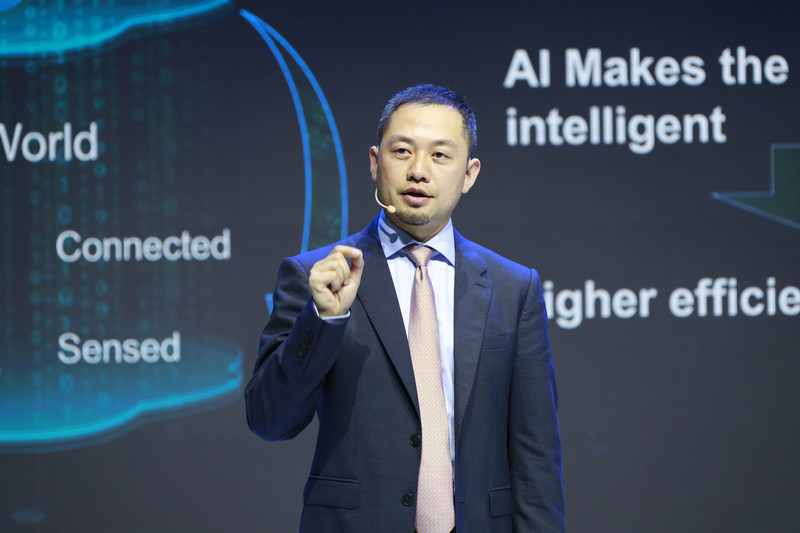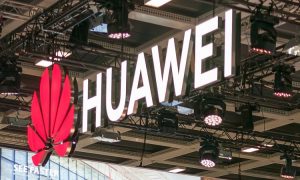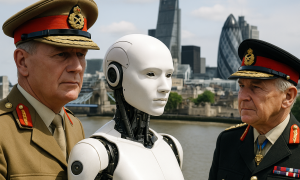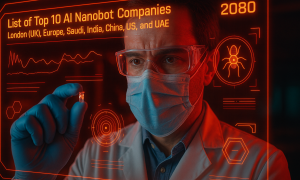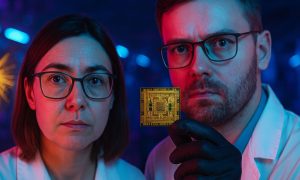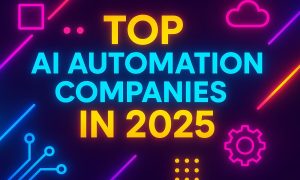

HANNOVER, Germany, June 11, 2018 /PRNewswire/ — At CEBIT 2018, Huawei released its latest IoT and AI products to help enterprises create intelligent and connectivity genes to build digital neurons and accelerate digital enterprise transformation.
At Huawei’s press conference at CEBIT, Qiu Heng, President of Global Marketing, Enterprise Business Group, Huawei, delivered a keynote speech titled “Creating Intelligence & Connectivity Genes for Enterprises’ Digital Neurons”. In his speech, Mr. Qiu explored how IoT helps enterprises connect the physical and digital worlds. IoT creates a cycle whereby sensors embedded in the physical world provide continuous feedback to the digital world which then controls the physical world. With IoT in place, AI helps this cycle become more efficient and automated to effectively merge the two worlds. IoT and AI will serve as the intelligent and connectivity genes in digital enterprises’ nervous system.
In this year’s CEBIT, Huawei released its latest IoT and AI products to help enterprises create intelligent and connectivity genes for their digital neurons, accelerating digital enterprise transformation.
Intelligent and Connectivity Genes Are Indispensable
Huawei’s Global Connectivity Index (GCI) report shows that intelligent connectivity will bring a new wave of innovation and drive economic development. By 2025, the digital economy is estimated to reach US$23 trillion in size. Intelligent connectivity will impact governments, public utilities, manufacturing, and many other sectors, and determine how industries manage their digital transformation.
In addition to its basic abilities in IoT, AI, big data, video, ICP, and GIS services, Huawei leverages its core abilities in chipsets, algorithms, and architecture design to build digital platforms. Huawei products cover from chips and terminals to cloud and edge computing infrastructures. These products feature ultra-high performance in computing, storage, and communications. In future digital enterprises, functional modules (also called neurons) will serve as digital platforms and end-to-end AI and IoT capabilities will enable the neuron’s intelligence and connectivity genes.
Better Intelligence Gene: Industry’s First AI-Enabled Software-Defined Camera
AI applications have been widely used in almost all industries. Auto-pilot, unmanned supermarkets, intelligent voice assistants and more. AI has become a “nuclear power plant” that drives digital industry transformation and AI development will depend on data, algorithms, and computing power. Among these three key elements, computing power can bring the most significant improvement in AI advancement. IDC analysis shows that from 2014 to 2020, data volume will increase by 5.5 times. Algorithms such as identification accuracy will improve by 4%. Whereas, computing power will grow by a staggering 30 times. This means a GPU will only need 1 day to finish a computing task that a CPU takes 30 days to complete. Gartner’s report says by 2022, the majority of industrial IoT analytics will be performed at the edge rather than in the cloud, up from less than 10% in 2017. This proves that AI’s rapid development relies on computing power improvement, particularly the improvement of edge computing power.
Huawei offers full-stack AI solutions that comprise chips, AI terminals, GPU servers, video PaaS cloud platforms, and more, to improve computing power and intelligence levels from end to end. At CEBIT 2018, Huawei released the industry’s first AI-enabled software-defined camera (SDC), the M/X series. This series of cameras can be applied to a vast range of scenarios and improve image processing capabilities by 25 times. In low-illumination environments, the characteristic acquisition rate exceeds 85%. These cameras also have a number of unique features:
- Environment Adaptive Operations: The cameras have preset parameter configuration for the day time, night time, and in different weather such as cloud, rain, and snow. When detecting time or whether changes, the cameras automatically adjust parameter settings to ensure video quality. No manual intervention is needed, which significantly improves the system operating efficiency.
- Front-end Intelligence: While traditional cameras can only run a single application, an M/X camera can dynamically load algorithms to run multiple applications.
- Continuous Evolution: Huawei cameras allow online upgrades to ensure continuous operation. In contrast, traditional cameras require remote manual upgrades which typically results in operational interruptions.
Upgrade of the Connectivity Gene: Connected Vehicle Platform and Wireless IoT Connectivity Solutions
In addition to the OceanConnect IoT Platform, Huawei’s IoT solution also includes wired and wireless connectivity, edge computing, and chipset (LiteOS) modules. The is the industry’s most comprehensive IoT solution, and Huawei continues to advance the solution to meet fast-evolving enterprise needs. At CEBIT Huawei unveiled: the upgraded OceanConnect IoT Platform which now supports Connected Vehicle systems; the eLTE-IoT Solution which has new capabilities to drastically improve performance; and the new eLTE-DSA Solution. These solutions are designed to significantly upgrade the platform’s connectivity gene.
The Connected Vehicle Platform is the key ICT infrastructure that enables automotive companies’ digital transformation. As the digital engine of intelligent and connected vehicles, this powerful OceanConnect IoV Platform provides four key enablers for the transformation of manufacturers:
- Connectivity enablement: The platform provides safe, reliable connectivity for vehicles, supporting hundreds of millions of connections and concurrent access from millions of vehicles. The flexible platform supports deployment in private, public and hybrid clouds, accommodating their different architectures. Huawei uses its global public cloud deployment capabilities to support automotive companies’ global business operations.
- Data enablement: The platform collects vehicle status and driving behavior data, and analyzes the data to create profiles of drivers and vehicles (Digital Twins) on the cloud. The precise analysis of driving behavior and scenarios enables intelligent content distribution and service recommendations.
- Ecosystem enablement: By separating data from services, the platform helps automotive companies control their digital assets, converge third-party content and applications, and build a thriving ecosystem around their business.
- Evolution enablement: The Connected Vehicle Platform interconnects with V2X. The cooperation covers vehicle intelligence and intelligent vehicle-road synergy to evolve the intelligent experience for drivers while delivering new levels of safety and efficiency.
The upgraded eLTE-IoT Solution uses technological innovation to further improve its performance. The solution now covers a radius of 10 km with 10% stronger signals. Its communications latency is reduced by 50% and the maximum standby time is extended to 10 years.
Newly unveiled by Huawei at CEBIT, the eLTE-DSA Solution uses Discrete Spectrum Aggregation (DSA) technology to create a large bandwidth spectrum through the convergence of small spectrums – some of which are continuous, while others are scattered. DSA technology can flexibly select and aggregate them to bring several valuable features. The solution supports the flexible aggregation of all the 280 spectrums around 230 MHz; Huawei will also promote the application of DSA in other frequencies in the future. eLTE-DSA also improves the overall coverage radius by 40% and the air interface latency is reduced to 20ms. In addition, the solution achieves five-nine (99.999%) in overall stability.
The release of these new products is just the beginning. Huawei will host the grand Huawei Connect 2018 in Shanghaithis October to present more AI products and launch its flagship digital platform. Huawei Enterprise BG follows the company’s vision and commitment, and aims to bring digital to every organization for a fully connected, intelligent world.
Huawei together with its partners and customers is showcasing new digital transformation solutions to orchestrate a digital symphony at CEBIT from June 11-15 in Germany, the home of classical music. It is also hosting activities and sharing best practices around Cloud Computing, Artificial Intelligence (AI), Big Data, Internet of Things (IoT) and Software-Defined Networking (SDN), all of which play a critical role in today’s digital transformation.
Huawei’s booth is at Area C01 in Hall 13, Hannover Exhibition Center, Germany. For more information about Huawei at CEBIT, please visit https://e.huawei.com/topic/cebit2018-en/index.html. To learn more about Huawei’s worldwide customer cases using “Leading New ICT”, please visit https://e.huawei.com/topic/leading-new-ict-en/index.html.
SOURCE Huawei


